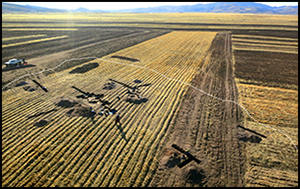Crossref Citations
This article has been cited by the following publications. This list is generated based on data provided by
Crossref.
Watson, James T.
and
Haas, Randall
2017.
Dental evidence for wild tuber processing among Titicaca Basin foragers 7000 ybp.
American Journal of Physical Anthropology,
Vol. 164,
Issue. 1,
p.
117.
Haas, Randall
Stefanescu, Ioana C.
Garcia-Putnam, Alexander
Aldenderfer, Mark S.
Clementz, Mark T.
Murphy, Melissa S.
Llave, Carlos Viviano
and
Watson, James T.
2017.
Humans permanently occupied the Andean highlands by at least 7 ka.
Royal Society Open Science,
Vol. 4,
Issue. 6,
p.
170331.
Juengst, Sara L.
Hutchinson, Dale L.
and
Chávez, Sergio J.
2017.
High altitude agriculture in the Titicaca basin (800 BCE–200 CE): Impacts on nutrition and disease load.
American Journal of Human Biology,
Vol. 29,
Issue. 4,
Juengst, S. L.
Chávez, S. J.
Hutchinson, D. L.
and
Chávez, S. R.
2017.
Late Preceramic Forager–Herders from the Copacabana Peninsula in the Titicaca Basin of Bolivia: A Bioarchaeological Analysis.
International Journal of Osteoarchaeology,
Vol. 27,
Issue. 3,
p.
430.
Lindo, John
Haas, Randall
Hofman, Courtney
Apata, Mario
Moraga, Mauricio
Verdugo, Ricardo A.
Watson, James T.
Viviano Llave, Carlos
Witonsky, David
Beall, Cynthia
Warinner, Christina
Novembre, John
Aldenderfer, Mark
and
Di Rienzo, Anna
2018.
The genetic prehistory of the Andean highlands 7000 years BP though European contact.
Science Advances,
Vol. 4,
Issue. 11,
Capriles, José M.
Albarracin-Jordan, Juan
Bird, Douglas W.
Goldstein, Steven T.
Jarpa, Gabriela M.
Calla Maldonado, Sergio
and
Santoro, Calogero M.
2018.
Mobility, subsistence, and technological strategies of early Holocene hunter-gatherers in the Bolivian Altiplano.
Quaternary International,
Vol. 473,
Issue. ,
p.
190.
Haas, Randall
and
Kuhn, Steven L.
2019.
Forager Mobility in Constructed Environments.
Current Anthropology,
Vol. 60,
Issue. 4,
p.
499.
Haas, Randall
Surovell, Todd A.
and
O'Brien, Matthew J.
2019.
Dukha Mobility in a Constructed Environment: Past Camp Use Predicts Future Use in the Mongolian Taiga.
American Antiquity,
Vol. 84,
Issue. 2,
p.
215.
Parker, Glendon J.
Yip, Julia M.
Eerkens, Jelmer W.
Salemi, Michelle
Durbin-Johnson, Blythe
Kiesow, Caleb
Haas, Randall
Buikstra, Jane E.
Klaus, Haagen
Regan, Laura A.
Rocke, David M.
and
Phinney, Brett S.
2019.
Sex estimation using sexually dimorphic amelogenin protein fragments in human enamel.
Journal of Archaeological Science,
Vol. 101,
Issue. ,
p.
169.
Haas, Randall
Watson, James
Buonasera, Tammy
Southon, John
Chen, Jennifer C.
Noe, Sarah
Smith, Kevin
Viviano Llave, Carlos
Eerkens, Jelmer
and
Parker, Glendon
2020.
Female hunters of the early Americas.
Science Advances,
Vol. 6,
Issue. 45,
Standen, Vivien G.
Santoro, Calogero M.
Arriaza, Bernardo
Coleman, Drew
Monsalve, Susana
and
Marquet, Pablo A.
2020.
Violence in hunters, fishermen, and gatherers of the Chinchorro culture: Archaic societies of the Atacama Desert (10,000–4,000 cal yr BP).
American Journal of Physical Anthropology,
Vol. 172,
Issue. 2,
p.
227.
Gagnon, Celeste Marie
2020.
Exploring oral paleopathology in the Central Andes: A review.
International Journal of Paleopathology,
Vol. 29,
Issue. ,
p.
24.
Haas, Randall
2021.
South American Contributions to World Archaeology.
p.
63.
Standen, Vivien G.
Santoro, Calogero M.
Arriaza, Bernardo
Verano, John
Monsalve, Susana
Coleman, Drew
Valenzuela, Daniela
and
Marquet, Pablo A.
2021.
Violence among the first horticulturists in the atacama desert (1000 BCE – 600 CE).
Journal of Anthropological Archaeology,
Vol. 63,
Issue. ,
p.
101324.
Bruno, Maria C.
Capriles, José M.
Hastorf, Christine A.
Fritz, Sherilyn C.
Weide, D. Marie
Domic, Alejandra I.
and
Baker, Paul A.
2021.
The Rise and Fall of Wiñaymarka: Rethinking Cultural and Environmental Interactions in the Southern Basin of Lake Titicaca.
Human Ecology,
Vol. 49,
Issue. 2,
p.
131.
Juengst, Sara L.
Hutchinson, Dale L.
Chávez, Karen Mohr
Chávez, Sergio J.
Chávez, Stanislava R.
Krigbaum, John
Schober, Theresa
and
Norr, Lynette
2021.
The resiliency of diet on the Copacabana Peninsula, Bolivia.
Journal of Anthropological Archaeology,
Vol. 61,
Issue. ,
p.
101260.
Chen, Caleb K.
Flores-Blanco, Luis
and
Haas, Randall
2022.
Why Did Projectile-Point Size Increase in the Andean Altiplano Archaic? An Experimental Atlatl Analysis.
Latin American Antiquity,
Vol. 33,
Issue. 3,
p.
616.
Kitchel, Nathaniel
Aldenderfer, Mark S.
and
Haas, Randall
2022.
Diet, Mobility, Technology, and Lithics: Neolithization on the Andean Altiplano, 7.0–3.5 ka.
Journal of Archaeological Method and Theory,
Vol. 29,
Issue. 2,
p.
390.
Zhao, Yuchao
Obie, Michael
and
Stewart, Brian A.
2023.
The archaeology of human permanency on the Tibetan plateau: a critical review and assessment of current models.
Quaternary Science Reviews,
Vol. 313,
Issue. ,
p.
108211.
Jorgensen, Kelsey
Garcia, Obed A.
Kiyamu, Melisa
Brutsaert, Tom D.
and
Bigham, Abigail W.
2023.
Genetic adaptations to potato starch digestion in thePeruvian Andes.
American Journal of Biological Anthropology,
Vol. 180,
Issue. 1,
p.
162.
